 |
Top Destinations |
|
|
|
 |
Travel Tools |
|
|
|
 |
|
|
Thailand hotel travel information and local guide
Thailand the land of smiles, where everyone is fun loving and happy go
lucky and the country itself is as diverse and spectacular as the glossy
postcards depict. It is a country where travel is reasonably cheap and
there is something for everyone. A land where boredom has been forgotten,
where the rain is warm, even pleasant and there is something for every
taste or desire.
Thailand, a land of contrasts, a land of genuinely beautiful people, a
land that once visited can be revisited again and again and one will never
tire of its diversity, spectacular scenery, friendliness and affordability.
A land that really is Paradise
Geography
The Kingdom of Thailand, covering an area of 514,000 square kilometres,
lies in the heart of Southeast Asia, roughly equidistant between India
and China. It shares borders with Myanmar to the west and north, Lao P.D.R.
to the north and northeast, Cambodia to the east and Malaysia to the south.
Climate
Thailand lies within the humid tropics and remains hot throughout the
year. Average temperatures are about 29°C, ranging in Bangkok from
35°C in April to 17°C in December. There are three seasons: the
cool season (November to February), the hot season (April to May), and
the rainy season (June to October), though downpours rarely last more
than a couple of hours.
Population
Thailand has a population of about 60 million. Ethnic Thais form the majority,
though the area has historically been a migratory crossroads, and thus
strains of Mon, Khmer, Burmese, Lao, Malay, Indian and most strongly,
Chinese stock produce a degree of ethnic diversity. Integration is such,
however, that culturally and socially there is enormous unity.
Religion
Thailand is one of the most strongly Buddhist countries in the world.
The national religion is Theravada Buddhism, a branch of Hinayana Buddhism,
practiced by more than 90 % of all Thais.
The remainder of the population adheres to lslam, Christianity, Hinduism
and other faiths - all of which are allowed full freedom of expression.
Buddhism continues to cast strong influence on daily life. Senior monks
are highly revered. Thus, in towns and villages, the temple (wat) is the
heart of social and religious life.
Meditation, one of the most popular aspects of Buddhism, is practiced
regularly by numerous Thai as a means of promoting inner peace and happiness.
Visitors, too, can learn the fundamentals of this practice at several
centres in Bangkok and elsewhere in the country.
-------------------------------
Topography
Thailand is divided into four distinct areas : the mountainous North,
the fertile Central Plains, the semi-arid plateau of the Northeast, and
the peninsula South, distinguished by its many beautiful tropical beaches
and offshore islands.
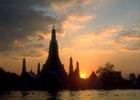 - The central region is considered the heartland of the
country. Basically it encompasses the alluvial plains created by the Chao
Phaya River. The region is the most fertile of the country, and due to
an extensive network of canals and small irrigation projects, the area
is a major producer of rice. It is also the most densely populated region
of the country, with the capital, Bangkok,
in its midst. Other areas include Pattaya,
Ayuthaya, Kanchanaburi,
Rayong, Chanthaburi and Trat. - The central region is considered the heartland of the
country. Basically it encompasses the alluvial plains created by the Chao
Phaya River. The region is the most fertile of the country, and due to
an extensive network of canals and small irrigation projects, the area
is a major producer of rice. It is also the most densely populated region
of the country, with the capital, Bangkok,
in its midst. Other areas include Pattaya,
Ayuthaya, Kanchanaburi,
Rayong, Chanthaburi and Trat.
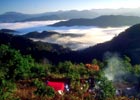 - This region is composed of a series of parallel mountain
ranges with an average elevation of 1,200m (3,900ft) above sea level,
incised by steep valleys of the Ping, Wang, Yom, and Nan rivers. A large
part of these mountains is still covered with tropical monsoon forests,
though the most valuable timber, teak, has been cut to a wide extent (the
government has now imposed a full logging ban). Doi Inthanon, with an
elevation of 2,595m (8,514ft) the highest point in the country, is located
in the extreme northwest of the region. The first three Thai kingdoms
in Indochina had their capitals in northern Thailand, at Sukhothai, Chiang
Mai and Chiang Saen. The second
largest city of present-day Thailand, Chiang Mai, is the center of the
northern region. The northernmost corner of northern Thailand belongs
to the region dubbed Golden Triangle - one of the world’s major producers
of opium. Other towns in the area include, Mae
Hong Son, Chiang Rai and Mae Sai. - This region is composed of a series of parallel mountain
ranges with an average elevation of 1,200m (3,900ft) above sea level,
incised by steep valleys of the Ping, Wang, Yom, and Nan rivers. A large
part of these mountains is still covered with tropical monsoon forests,
though the most valuable timber, teak, has been cut to a wide extent (the
government has now imposed a full logging ban). Doi Inthanon, with an
elevation of 2,595m (8,514ft) the highest point in the country, is located
in the extreme northwest of the region. The first three Thai kingdoms
in Indochina had their capitals in northern Thailand, at Sukhothai, Chiang
Mai and Chiang Saen. The second
largest city of present-day Thailand, Chiang Mai, is the center of the
northern region. The northernmost corner of northern Thailand belongs
to the region dubbed Golden Triangle - one of the world’s major producers
of opium. Other towns in the area include, Mae
Hong Son, Chiang Rai and Mae Sai.
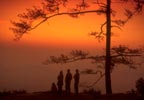 - Theregion principally consists of a saucer shaped plateau
known as Khorat Plateau with an average elevations of 200m (650ft). The
region’s soils are poor and sandy and rainfall is scant except for
the rainy season from June to October when much of the land is flooded.
Areas not used for agriculture are largely covered with savanna-type grasses
and shrubs. The Northeast is the least developed region of the country,
and the least favored by tourists. Accommodation in the area is available
in a number of areas and some of these include, Khon Kaen, Roi Et and
Surin. - Theregion principally consists of a saucer shaped plateau
known as Khorat Plateau with an average elevations of 200m (650ft). The
region’s soils are poor and sandy and rainfall is scant except for
the rainy season from June to October when much of the land is flooded.
Areas not used for agriculture are largely covered with savanna-type grasses
and shrubs. The Northeast is the least developed region of the country,
and the least favored by tourists. Accommodation in the area is available
in a number of areas and some of these include, Khon Kaen, Roi Et and
Surin.
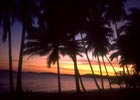 - This part of the country, geographically the southern edge
of northeastern Thailand along the Gulf of Thailand, has not traditionally
been considered a separate region of the country. The division, often
made today, is based on administrative and social factors more than on
geological features. The region is distinguished from the Northeast in
that it is far richer - the second richest region of the country, after
the central plain. The East Coast has a well-established industrial and
tourist infrastructure. Furthermore contributing to the region’s
wealth are extraordinary fruits (durians and mangos) as well as extraordinary
stones (rubies and sapphires). Phetchaburi, Hua
Hin, Cha Am, Koh
Samui, Koh Pangan, Koh Tao and Songkla are some of the areas on the
east coast. - This part of the country, geographically the southern edge
of northeastern Thailand along the Gulf of Thailand, has not traditionally
been considered a separate region of the country. The division, often
made today, is based on administrative and social factors more than on
geological features. The region is distinguished from the Northeast in
that it is far richer - the second richest region of the country, after
the central plain. The East Coast has a well-established industrial and
tourist infrastructure. Furthermore contributing to the region’s
wealth are extraordinary fruits (durians and mangos) as well as extraordinary
stones (rubies and sapphires). Phetchaburi, Hua
Hin, Cha Am, Koh
Samui, Koh Pangan, Koh Tao and Songkla are some of the areas on the
east coast.
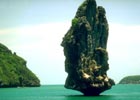 - Occupying the northern half of the Malay Peninsula,
the region has a rolling to mountainous topography with little flat land.
The countryside is often breathtaking, and this asset is increasingly
tapped for the development of tourism. Traditionally, the region’s
relative wealth stems from its most important natural resources, tin and
rubber. This is the most popular area for tourists and areas within this
region include, Phuket, Krabi,
Phang Nga, Koh
Phi Phi, Koh Lanta, Koh
Yao (Noi and Yai) and numerous other islands. - Occupying the northern half of the Malay Peninsula,
the region has a rolling to mountainous topography with little flat land.
The countryside is often breathtaking, and this asset is increasingly
tapped for the development of tourism. Traditionally, the region’s
relative wealth stems from its most important natural resources, tin and
rubber. This is the most popular area for tourists and areas within this
region include, Phuket, Krabi,
Phang Nga, Koh
Phi Phi, Koh Lanta, Koh
Yao (Noi and Yai) and numerous other islands.
|
|
 |
Travel
Guides |
|
|
 |
|

